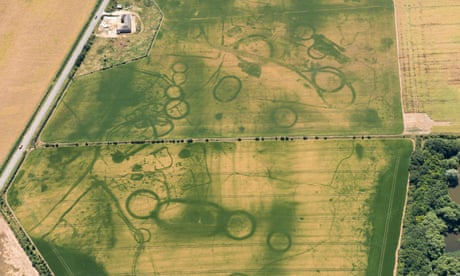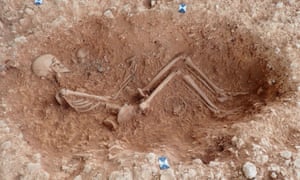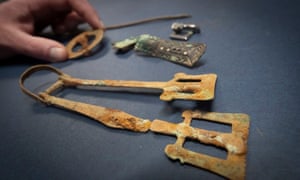What this shows is that the appetite for exotic goods continued after the Roman exit. Earlier eras tended toward more closed communities possibly even hostile to traders and perhaps much less traffic. Yet the real issue was the use of copper and the use of copper alloys which was used for most manufactures along with wood.
The metal served a dual purpose of currency as well. Thus it was constantly recycled. This economy extended to some degree to iron but there abundance and rust created much more wastage.
Most of the mined copper remained in circulation to this day. We still generally avoid wasting it.
Burial sites from 5th and 6th centuries yield unexpected treasures
Jewellery and grooming items found during summer excavation in Lincolnshire
Haroon Siddique
Tue 27 Nov 2018 00.01 GMT
Some of the artefacts discovered during excavations in Lincolnshire. Photograph: Danny Lawson/PA
https://www.theguardian.com/science/2018/nov/27/burial-sites-5th-6th-centuries-yield-female-treasures-lincolnshire
Archaeologists have uncovered lavish burial sites for women in Lincolnshire from the fifth and sixth centuries, which illustrate how women of the time made themselves resplendent.
Items recovered from the previously unknown Anglo-Saxon cemetery include jewellery made from amber, silver and glass as well as personal grooming items such as tweezers.
Dr Hugh Willmott, senior lecturer in European historical archaeology from Sheffield University and a dig leader, said: “These women wore necklaces made from sometimes hundreds of amber, glass and rock crystal beads, used personal items such as tweezers, carried fabric bags held open by elephant ivory rings, and wore exquisitely decorated brooches to fasten their clothing.
“Two women even received silver finger rings and a style of silver buckle commonly associated with Jutish communities in Kent.”

Hugh Willmott, of Sheffield University, with a skull discovered at one of the sites.
Photograph: Danny Lawson/PA
He described the latter finds as out of context in Lincolnshire, which was conquered by Angles from Germany after the Romans left. Further investigation into one of the buried women, using stable isotope analysis of teeth and bone, revealed that she grew up in the chalk lands of the South Downs.
“Its not just the objects that have moved up [the country] but the people themselves,” said Willmott. “This is showing perhaps that people were moving about within the British Isles as well as from Europe. There was wider contact than we might expect.”
The elephant ivory rings travelled even further, from sub-Saharan Africa, which, Willmott said, in the context of the time, “might as well have come from the moon”.

UK archaeology sites made visible in heatwave – pictures
He said the tweezers were presumably used to pluck hairs as they would be today but their discovery should not prompt surprise. “We have these impressions that people in the Dark Ages just chucked mud at each other,” he said, joking: “It’s Monty Python that’s the problem.
“But I think in all eras, males and females were interested in personal hygiene – it’s also about health.”
One of the most striking burials was that of a richly-dressed woman who was buried with a baby cradled in her left arm. By comparison, the male burials were relatively unsurprising, yielding spears and shields.
The dig of the cemetery, containing 20 burials, was carried out over the summer by international volunteers, Sheffield University students and members of the RAF. Its existence came to light last year when a local metal detectorist discovered a number of Anglo-Saxon artefacts, including copper gilded brooches, iron shield bosses and spear heads.

A skeleton at the female burial site. Photograph: University of Sheffield/PA
The university’s archaeology department is carrying out a series of scientific investigations, which it is hoped will help uncover more details about the site and those buried there, including their age, where they grew up, what they ate, and where exactly in Africa the ivory came from.
Dr Katie Hemer, lecturer in bioarchaeology at Sheffield University and co-dig leader, said: “Cutting-edge scientific techniques will enable Sheffield archaeologists to ask and answer significant questions about early Anglo-Saxon communities in eastern England.”
The excavation will feature on Digging for Britain on BBC4 at 9pm on Wednesday.

No comments:
Post a Comment